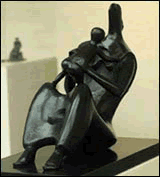 An exhibition featuring 118 original sculptures by Henry Moore (1898-1986), one of the most prominent artists of the 20th century, will run at the Shanghai Art Museum from March 3 to April 15.
An exhibition featuring 118 original sculptures by Henry Moore (1898-1986), one of the most prominent artists of the 20th century, will run at the Shanghai Art Museum from March 3 to April 15.
Organized by the British Consulate General and the Henry Moore Foundation, and sponsored by British Petroleum and Shanghai Shenmei Beverage & Food Co., the show is the first display of Henry Moore's works in the city. The selections were created between 1929 and 1983.
"Shanghai is the third stop of this touring exhibition on the Chinese mainland, after Beijing and Guangzhou," said Li Xiangyang, the museum curator. "Because of the problem of transporting some of the bigger pieces, 12 sculptures have been left on show in Beijing's Beihai Park."
Even so, local art lovers have plenty to compensate themselves with.
"Mother and Child" shows one of Moore's key themes, depicting a vulnerable interior part shielded by the encircling, embracing outer form. Through his characteristic use of geometric shapes, Moore reveals the subtle relationship of the two.
"Moore's works are apparently simple, but can stand careful viewing and appreciation for a lasting period," said 61-year-old Zhao Zhirong, a noted Shanghai sculptor and creator of works of public art on display in Pudong. "Moore fused a new art concept, which was totally different from Michelangelo or Rodin."
According to Tim Marlow, an English expert on Moore, his works of the 1920s show the influences of early native Americans art combined with Italian Renaissance artists such as Michelangelo. Marlow, who will give a series of lectures to accompany the exhibition, says that from the 1930s the works of Pablo Picasso and fellow contemporary abstract artists became strong influences, leading Moore down an ever more abstract path.
But, said Zhao, "Moore's work was not immediately recognized by critics."
And it wasn't simply lack of recognition that Moore faced in the earlier years of his career - critics were often vituperative.
The art critic of the London Morning Post, for instance, wrote in April 1931 that "The cult of ugliness triumphs at the hands of Mr. Moore. He shows an utter contempt for the natural beauty of women and children and in doing so, deprives even stone of its value as a means of aesthetic and emotional expression.
"Such voices did not deter Moore from the path he had chosen; by the time of his death, the press were adoring.
"I saw some of his works nearly a decade ago in Hong Kong. They'd been put on the sea shore," Zhao said. "To be frank, I was dumbfounded at the first sight of them. The sizable sculptures had an overwhelming and moving impact. For example, he carved a concave shape or even a hole when depicting the breasts of a woman, rather than give them the careful, realistic focus other artists might use. Yet his female forms achieved a fusion of figure and landscape, abstract yet recognizable."
That's perhaps the reason why critics say that Moore's sculptures work in perfect harmony with a natural environment. Their swelling shapes, undulating extensions and rounded indentations all mirror natural forms.
Indeed, Zhao likens Moore's works to the unchiselled stone figures from Taihu Lake in East China's Jiangsu Province.
"Stones from Taihu Lake are known for their delicate beauty and complex shapes, which have been created by years of erosion. Akin to Moore's works, they are simple and have no redundancy."
During the exhibition, lectures, seminars and children's activities will also be held.
(Eastday.com.cn 03/01/2001)
